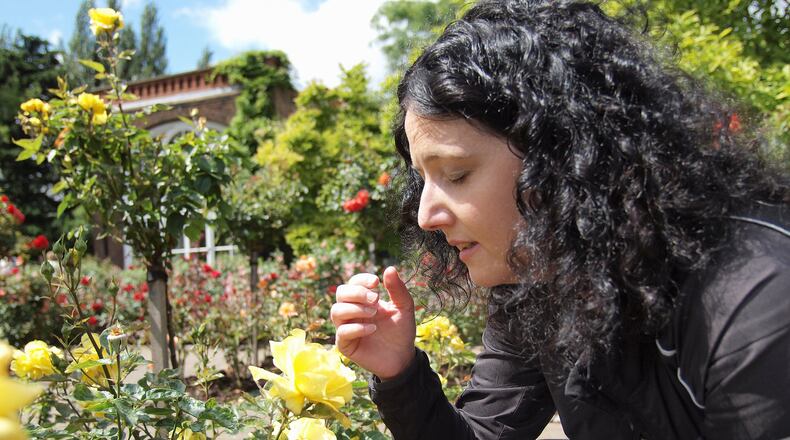“It’s not unfair to say that Cincinnati has a reputation for allergies,” she said. “In the fall, typically in August and September, ragweed is prevalent in greater Cincinnati.”
Dayton’s reputation is even worse, ranking highest in the Midwest for allergy sufferers, according to one survey last fall.
RELATED: Allergy sufferers beware
Landry said in the spring there are a lot of trees and other plant life releasing pollen.
“We’re getting into spring with warm breezy days that spread pollen, which is why people are feeling those symptoms,” she said. “We had a spike in February during the warm weather during the Presidents Day weekend.”
Landry said the region experienced a pretty mild winter this year, but when the temperatures go up, that’s when the trees begin to their pollenization.
Pollen from trees, grasses and weeds are the main cause of allergies and allergy symptoms, such as sinus headaches, irritated eyes, sneezing, coughing and congestion.
Landry said the pollen count is collected over a 24-hour period, every 10 minutes during the day. She said pollen is measured in grains per cubic meter of air. The ranges are 0 to 20 is low; 21 to 100 is moderate; 101 to 1,000 is high; and 1,001 or more is very high.
Monday’s pollen count was 773 with oak trees having nearly 50 percent of the count with 366. Birch trees accounted for 129; and other trees such as sycamore, hickory and poplar combining for 166. There were other types of pollen that combined for 112.
RELATED: Employers tracking medication use
She said over the past 10 years, the pollen count has averaged about 513, which is in the high range but less than Monday’s pollen count.
“It varies from year to year, and much of it is weather-dependent,” Landry said. “Each spring we expect to see rising pollen counts in April.”
Landry said with Tuesday’s rainfall, she is expecting a lower pollen count to be recorded.
She said the agency also lists the pollen count each day from February through November at its website.
Last fall, the Cincinnati area ranked 66th in the nation’s top 100 “Fall Allergy Capitals” list compiled by the Asthma and Allergy Foundation of America. The organization has not released its spring list for 2017. In comparison, the Dayton area ranked first in the Midwest and eighth nationwide.
Doctors and pharmacists suggest that people suffering from allergies minimize outdoor activity when pollen counts are high, and shut windows and doors — especially overnight while they sleep. Pollen levels tend to be highest early in the morning.
“Whether it’s pollen from flowers and trees or environmental factors like mold and dust affecting allergy sufferers, the important thing is to minimize or treat the symptoms before they begin to escalate,” said Karen Mankowski, vice president of pharmacy operations for Meijer stores.
When symptoms hit, the first line of defense for many allergy sufferers is to use prescribed or over-the-counter sedating antihistamines.
The annual cost of allergies, including doctor visits and medication, is nearly $14.5 billion, according to the Centers for Disease Control and Prevention.
But that doesn’t include the indirect cost of allergies, such as diminished productivity from employees who are present at work but distracted by their symptoms or feeling drowsy after taking prescribed or over-the-counter medicines.
A recent study projected that the use of sedating antihistamines by workers could result in a 25 percent reduction in productivity for two weeks per year and a cost to U. S. corporations of as much as $2.8 billion per year.
Overall, seasonal allergies result in nearly 4 million missed or lost workdays each year, costing more than $700 million in total lost productivity, the National Academy on an Aging Society estimates.
Five Remedies for Fighting Allergies:
• Antihistamines: Can be taken by mouth or as a nasal spray, relieving sneezing and itching in the nose and eyes. They also reduce runny nose and, to a lesser extent, nasal stuffiness.
• Nasal Corticosteroids: These anti-inflammatory medicines can reduce all symptoms when taken regularly, and can help block allergic reactions. They are widely considered to be the most effective medication for allergic rhinitis. Combining an antihistamine with a corticosteroid appears to be more effective than either of the nasal sprays alone.
• Decongestants: Intended for short-term use, oral and nasal decongestants help decrease swelling of the nasal passages, relieving nasal stuffiness.
• Leukotriene Receptor Antagonists: Leukotriene Receptor Antagonists, such as the prescription drug montelukast (Singulair®), block the action of leukotrienes – the chemical messengers involved in allergic reactions – when taken daily.
• Natural remedies include neti pots, saline spray, honey, herbs (spirulina, eyebright and goldenseal), steam showers, spicy foods, tea and eucalyptus oil.
Source: Meijer

